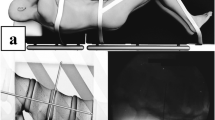Abstract
Background
Thoracic disc herniation (TDH) is a rare condition with severe neurological sequelae. Surgical management is still a matter of debate and challenging.
Method
We present a modification of the transdural approach for TDH. The approach has been described in a stepwise fashion, analysing pre-, peri-, and postoperative strategies to improve patients’ management and reduce approach-related morbidity.
Conclusion
The modified posterior transdural approach represents an effective technique for TDH, minimizing the risk of spinal cord damages, which can dramatically affect the outcome.




Similar content being viewed by others
References
Aizawa T, Sato T, Ozawa H, Morozumi N, Matsumoto F, Sasaki H, Hoshikawa T, Kawahara C, Kokubun S, Itoi E (2008) Sagittal alignment changes after thoracic laminectomy in adults. J Neurosurg Spine 8:510–516. https://doi.org/10.3171/spi/2008/8/6/510
Coppes MH, Bakker NA, Metzemaekers JD, Groen RJ (2012) Posterior transdural discectomy: a new approach for the removal of a central thoracic disc herniation. Eur Spine J 21:623–628. https://doi.org/10.1007/s00586-011-1990-4
Lowe SR, Alshareef MA, Kellogg RT, Eriksson EA, Kalhorn SP (2019) A novel surgical technique for management of giant central calcified thoracic disk herniations: a dual corridor method involving tubular transthoracic/retropleural approach followed by a posterior transdural diskectomy. Oper Neurosurg 16:626–632. https://doi.org/10.1093/ons/opy225
Moon SJ, Lee JK, Jang JW, Hur H, Lee JH, Kim SH (2010) The transdural approach for thoracic disc herniations: a technical note. Eur Spine J 19:1206–1211. https://doi.org/10.1007/s00586-010-1294-0
Sliwa JA, Maclean IC (1992) Ischemic myelopathy: a review of spinal vasculature and related clinical syndromes. Arch Phys Med Rehabil 73:365–372. https://doi.org/10.1016/0003-9993(92)90011-k
Author information
Authors and Affiliations
Corresponding author
Ethics declarations
Conflict of interest
The authors declare that they have no conflict of interest.
Ethical approval
All procedures performed in studies involving human participants were in accordance with the ethical standards of the institutional research committee and with the 1964 Helsinki declaration and its later amendments or comparable ethical standards.
Informed consent
Informed consent was obtained from all individual participants included in this study.
Additional information
Key Points
1. Due to its rarity, make sure to determine the correct diagnosis of TDH through different examinations, such as careful neurological testing, thoracic CT and MRI imaging studies, and neurophysiological studies.
2. The PTA seems less invasive than other described techniques.
3. We do not recommend PTA for calcified TDH.
4. In this technical variant, the drilling of the omolateral caudal pedicle and transverse process allows a more lateral displacement of the dural flap gaining a wider intradural surgical corridor.
5. The PTA for central soft TDH avoids tractions over a “closed” dural sac. During extradural posterolateral thoracic approaches, mild traction to the dural sac can reduce spinal cord blood flow in an already suffering tissue, increasing morbidity.
6. Plenty cerebrospinal fluid drainage after dural opening in PTA is a key point for spinal cord protection.
7. Adequate blood pressure control during surgery is mandatory to reduce the risk of further spinal cord hypoxia due to hypotension.
8. It is not necessary to close the anterior portion of the dura mater after TDH removal because of its natural tight adhesion to the anterior anatomic structures and the consequent low risk of leak [4]. Spinal fusion is usually not needed.
9. Neurosurgeons are more confident with transdural approaches, and a short learning curve is required [2].
10. Compared with other techniques, in transdural approaches to TDH, a lower rate of postoperative severe complications has been reported, and patients are able to start the rehabilitation program few days after surgery [2, 4].
Publisher’s note
Springer Nature remains neutral with regard to jurisdictional claims in published maps and institutional affiliations.
This article is part of the Topical Collection on Spine degenerative
Electronic supplementary material
Step-by-step explanatory video of the posterior transdural approach for central soft thoracic disc herniation
(MP4 259,441 kb)
Rights and permissions
About this article
Cite this article
Mandelli, C., Spina, A., Calvanese, F. et al. How I do it: posterior transdural approach for central soft thoracic disk herniation. Acta Neurochir 162, 2051–2054 (2020). https://doi.org/10.1007/s00701-020-04387-6
Received:
Accepted:
Published:
Issue Date:
DOI: https://doi.org/10.1007/s00701-020-04387-6




